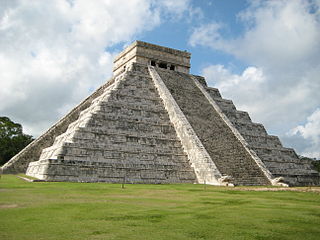Visiting the Remnants of Mayan Civilization is A Breath-Taking Experience
by Giselle Sanchez, age 11

Imagine
standing at the foot of a huge Chichén Itzá pyramid in Mexico, as I
did recently during a family trip. I took in the enormity of the
pyramid and its vast desert-like surroundings. I felt speechless at
the thought that many years ago the place where I was standing was
the heart of the Mayan civilization. The Mayan civilization
flourished for more than seven hundred years.
The
Maya lived in organized city-states in Central America from 200 A.D.
to the early 1500s when Spanish explorers took over. Each city-state
regulated trade of cacao, cotton, grain and other goods with
neighboring city-states. The largest Mayan city was Tikal, in what is now known
as Guatemala, with a population of 60,000.
Farming
was a big part of Mayan life. The Maya grew beans, corn, squash,
onions, and carrots. Some animals that the Maya had were turkeys and
kept bees. Dogs were the only domesticated animals, during that time.
Religion
was a very important part of Mayan culture. In the square, priests
foretold when the next eclipses of the moon and the sun could occur.
To get a favor from the gods the citizens would sacrifice animals and
sometimes even humans.
The
Maya also made time for fun. They invented a sacred game using a
rubber ball, which they hit with their hips through a stone hoop. On
my trip I saw how thick the hoops actually were. They were a sight to
see.
The
Maya were very intellectual. They invented the first writing in
America, they wrote codexes, folding books that were written on tree
bark. Only three codexes survive today. Unlike our number system, the
Mayan number system was based on 20 (instead of 10), and their
farmers’ calendars had 18 months of 20 days each.
Mayan
culture began to die off during the 1500’s, most likely as a result
of the Spanish conquest of Central America. We are still not sure why
the Mayans disappeared but some think it was because of a disease.
The Mayan language has been passed on and some people still speak it
today.
[Source:
World History
Encyclopedia
]
|

